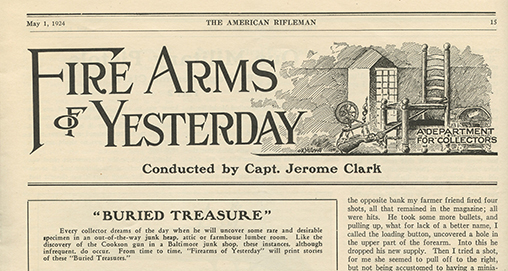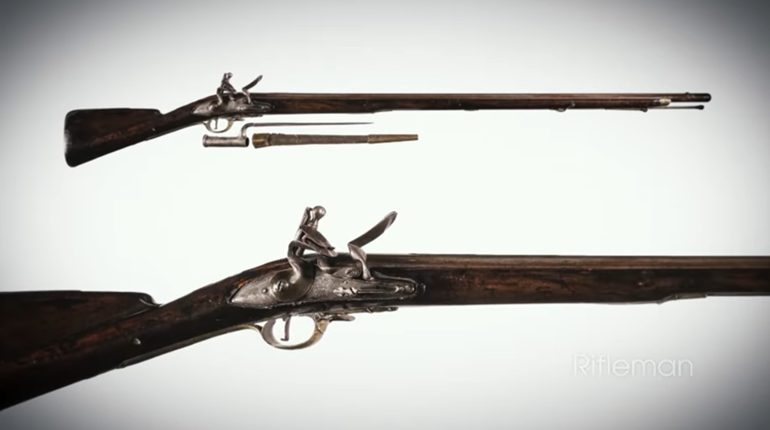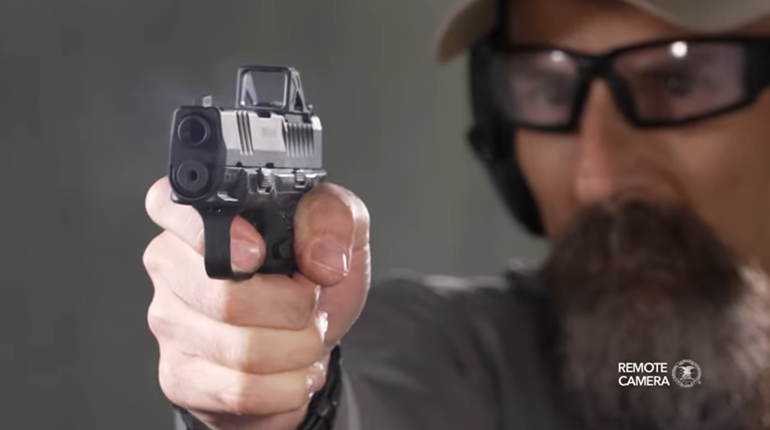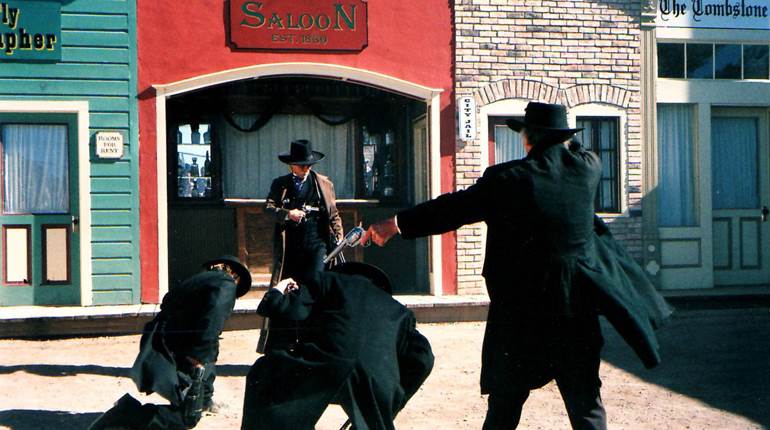
Conducted by Capt. Jerome Clark
Every collector dreams of the day when he will uncover some rare and desirable specimen in an out-of-the-way junk heap, attic or farmhouse lumber room. Like the discovery of the Cookson gun in a Baltimore junk shop, these instances, although infrequent, do occur. From time to time, "Firearms of Yesterday" will print stories of these "Buried Treasures."
The Lost Masterpiece
By B.L. Albertson Jr.
I saw it once. Had it in my hands. Worked its ingenious mechanism. Thrilled over the magnificent though minute sculpturing of the nude figure that formed the trigger guard and the dolphin head that held the flint. Felt my face against the age-glossed burl of the most wonderfully-grained stock I have ever seen. Fired it!
That was years ago. Since then, I have learned the old repeating flintlock has gone on new wanderings perhaps as wide as when it came to the new colonies from the old world. I have never ceased regretting that I could not persuade the strange old man who hunted with it there in the South Carolina sea coast country to part with it. Only that fine old piece in my gun rack can cure me of the worst attack of "Collectors Ague" I have ever had. It is in the hope that some "brother in arms" will know something of its whereabouts or can tell me something of the piece that I am telling the story.
Some little time before the war, I was down in South Carolina (had my vacation on a barge that year), and went out in a small boat for some shooting. About a mile above where we were tied up I heard some shooting and pulled in to have a look. Even at that early day I was gun curious, and, when I saw the gunner, pulled over to get acquainted.
He was a typical small southern farmer and we soon were talking and trading arms inspection. Mine was only a Marlin .22 but his-It was as he said "real old", an early flintlock and a repeater of most amazing beauty and in wonderful condition.
The gun was some around 50 inches over all. The stock seemed to be Italian Walnut and when he explained her operation I found she was a lever operated repeater. All parts of the gun were engraved and inlaid. The lever was the trigger guard, made to form the figure of a nude woman tied to the rim of a wheel. This operated a sliding breech block, working in a well, somewhat like the magazine of the Springfield. Directly below the barrel was the powder magazine, opened in the decent of the block by a finger. Under this was the tubular bullet container.
The chamber of the gun was separate from but attached to this sliding block, and was housed over its top, the flash pan being a part of the chamber. At the junction of chamber and barrel was a chamfer. In use she worked somewhat as follows:
The flash pan rested, in firing, directly under the battery, after being fired the battery, instead of rolling over on the battery screw, had slid forward (exposing a priming charge dropped from the battery magazine). In reloading, the hammer was brought to the cock, the pan (used as a bolt handle by the right hand) was turned up and to the left. The muzzle elevated, as at the "charge". Then by pulling down on the trigger guard the chamber dropped into the well, in going down the face of the block engaged the stop of the powder magazine and took in a charge, when at the lowest point the left hand pulled back the stop. This inserted and seated the bullet. The trigger guard was pushed up, pan turned to right on fence and battery returned to place, ready to go. Sounds complicated but was as fast as a modern single shot B-L.
After chinning awhile, I suggested that we try her on a target, and selecting a stump on the opposite bank my farmer friend fired four shots, all that remained in the magazine; all were hits. He took some more bullets, and pulling up, what for lack of a better name, I called the loading button, uncovered a hole in the upper part of the forearm. Into this he dropped his new supply. Then I tried a shot, for me she seemed to pull off to the right, but not being accustomed to having a miniature volcano erupt near my eye may have had something to do with that. Its old style stock seemed to lighten the recoil, as I had expected at least that of the .44, but felt no more than the little jounce one gets from a reduced .30-06.
After trying her out we chatted awhile, he admiring my Marlin with its peep sight and nice balance.
When I suggested getting back to my barge he invited me back to his "place" for a snack, I accepted. A short pull up stream and into what he called a branch landed us at the place. It had been one of those old farm houses we read about, not pretentious but fairly large; now only the small ell was used, the larger portion was a wreck-windows out and the roof most gone. He lived in the three habitable rooms, and form their appearance the Civil War was young when the last woman had seen them. We snacked and talked mostly guns and gunning. After the usual after dinner smoke he cleaned up the bore of his beauty and told me what he could of her history, showed me the gun case, mould, tools and one of a pair of pistols that were her running mates. The pistol, aside from its workmanship was the usual pattern of early flintlock, the mould cast two bullets at a time-one for the rifle, the other for the pistol. The pistol bullet was of the same caliber but was only the larger half. The box was of walnut, but had neither maker's name nor date. The outfit had been brought to America by his people, and had remained with them since, except for one of the pistols. This had been taken by one of the family to the Seminole Wars and neither ever came back.
As he had admired my rifle so much, I tried to make a dicker with him, but after going my limit (the gun and $25.00) I gave up and left. If I had known as much then as now, I would have included my pants and shirt. I did not think much more about it until I had taken up the study of ancient arms, when I realized what a prize it was, and in the early part of '21 went back to try again. Not knowing my friend's last name made things rather difficult, but I found the place empty. After traveling and talking more than a bit, I got together the following information.
My friend had died during the war "flu epidemic" and as there were no known "kin" his few effects had been sold to bury him. As on every farm, there had been many unsalable items, these had been lumped and sold as a lot. Who got them was not known, but it was recalled that a traveling peddler, or junk man, had been around about that time and may have taken the lot. They generally do, as the old guns bring so very little because not appreciated. I bought three flintlock shotguns and a rifle on this trip for one dollar, another "Miscellaneous" lot.





































